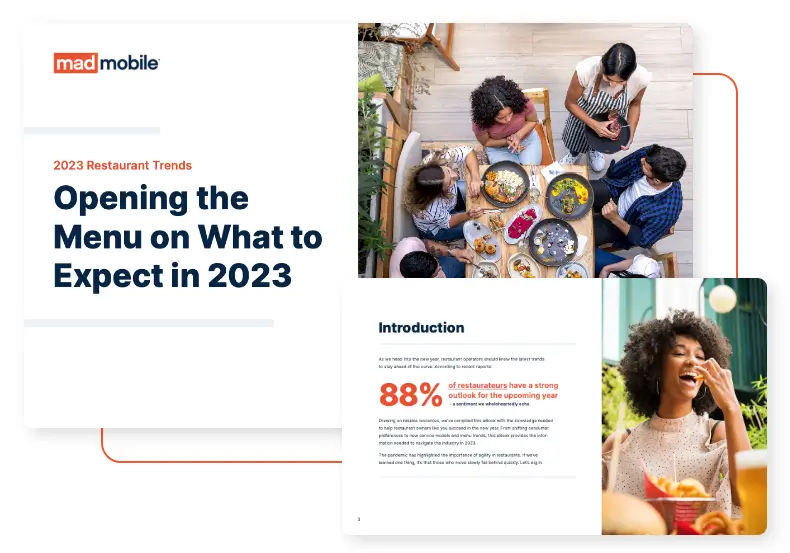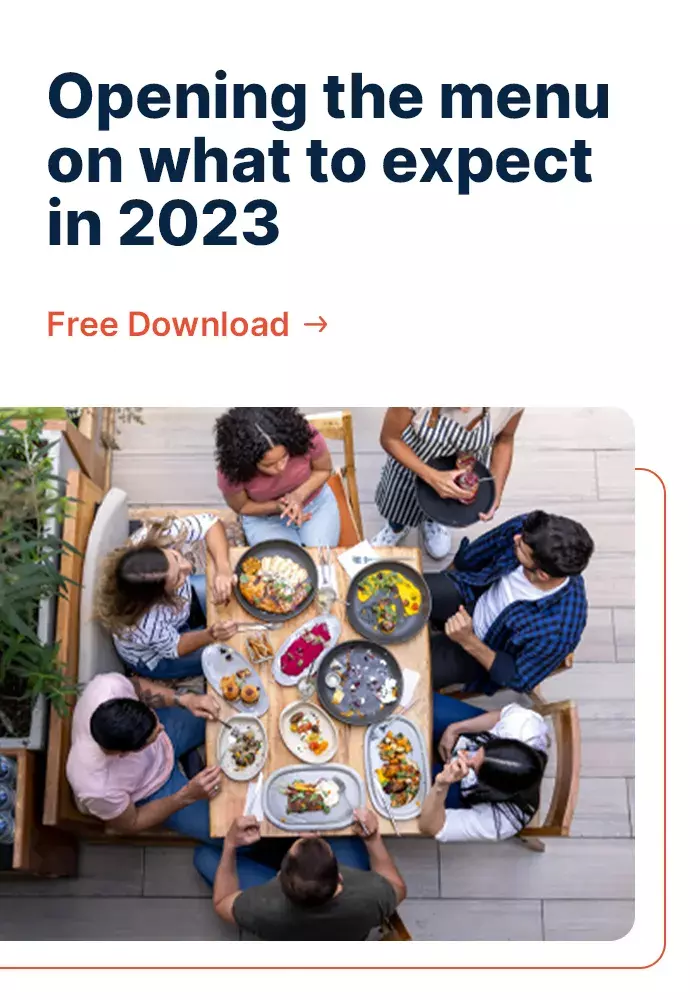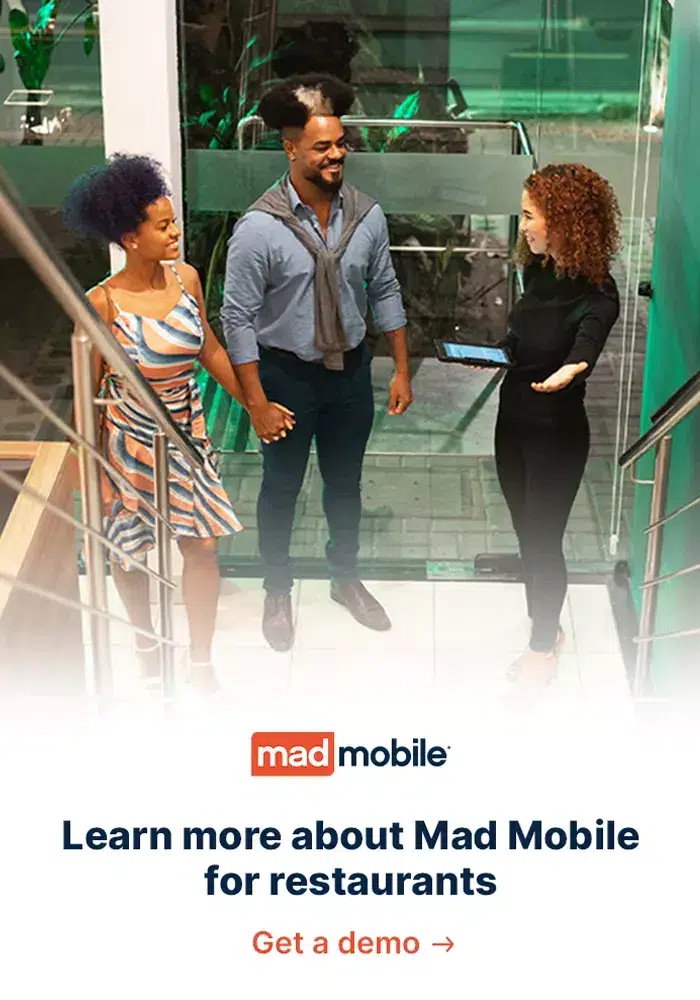
Download your free copy here
As we head into the new year, restaurant operators should know the latest trends to stay ahead of the curve. According to recent reports, 88% of restaurateurs have a strong outlook for the upcoming year – a sentiment we wholeheartedly echo.
Drawing on reliable resources, we’ve compiled industry insights with the knowledge needed to help restaurant owners as you succeed in the new year. From shifting consumer preferences to new service models and menu trends, this resource provides the information needed to navigate the industry in 2023.
The pandemic has highlighted the importance of agility in restaurants. If we’ve learned one thing, it’s that those who move slowly fall behind quickly. Let’s dig in.
The biggest trends in the restaurant industry
- Contactless ordering is shaping the future of dining
- Restaurants are combating inflation with menu price hikes
- Food delivery remains more important than ever
- Using data to understand consumer preferences becomes a priority
- Labor shortage leads to smart tech automation
- Charcuterie boards + An elevated dining experience = 🤝
- Customers want to be served a clean plate
- More sustainable and environmentally friendly restaurant options
- Menus going more toward the grain
1. Contactless ordering is shaping the future of dining
The restaurant industry is evolving, and contactless ordering is leading the way. With this ordering method, guests can place orders from the comfort of their own device, at home, or in your restaurant. You can also integrate the idea of contactless through kiosks, curbside, and tableside ordering. Rounding out the experience, contactless payments are in just as high demand for consumers’ convenience and peace of mind.
This trend is helping restaurants cut down on wait times and increase staff efficiency. Contactless ordering methods, such as online or through QR codes, will become even more popular in 2023. Simplifying the ordering and payment process can lead to higher revenues and happier customers.
2. Restaurants are combating inflation with menu price hikes
Restaurateurs face increasing costs due to inflation, leading many to increase their prices. Rewards Network found that out of 1,000 operators – 91% had to raise menu prices in 2022.
To counterbalance price increases, restaurant owners can offer value-added items such as a complimentary appetizer or dessert with a main course, a loyalty program, happy hour specials, and “kids eat free” promotions. It is important to note that it is crucial not to raise prices too much and risk losing existing customers.
Helpful resources:
- 8 Techniques for Controlling Restaurant Food Costs
- How to Perform A Menu Analysis
- How to Tactfully Change Menu Prices
3. Food delivery remains more important than ever
One of the important restaurant trends during COVID has been food delivery. Over the past decade, searches for “food delivery apps” have grown by 4,400%. This is a prime sign of the growth of digital consumers looking up restaurants online and placing orders for delivery.
Restaurants can make it easier to receive orders by linking their point of sale (POS) system with a delivery order system. This means that all orders are managed in one place, making it much faster to process orders and get them to customers.
According to the 2023 POS Software Trends Report from Hospitality Technology, operators are keen to have integration capabilities with other systems (71%) and delivery functionality (43%). To maximize profits, restaurants are responding to customer preferences by either providing their own delivery service or partnering with third-party providers like Uber Eats and DoorDash.
4. Using data to understand consumer preferences becomes a priority
Gathering data to gauge customer behavior has become a prime focus of restaurants looking to upgrade their POS systems. This is one of the leading business drivers impacting restaurant operations today. Meaning, more restaurants will attempt to keep customers returning by changing or adding loyalty programs.
From post-visit messaging to restaurant sales data, operators can use insights into consumer behavior to create a better overall dining experience. Restaurateurs can then use these insights to personalize selling items, adjust restaurant operations accordingly, or launch new marketing campaigns tailored specifically to their customers.
Loyalty and rewards programs have come to the forefront as an effective means of customer retention and business growth. A survey from Rewards Network showed that 73% of restaurants utilizing loyalty programs deemed them to be critical or important for their post-pandemic prospects, while 54% of those without such programs held similar beliefs.
Restaurant owners should take advantage of the data they collect to understand their customers better and stay ahead of emerging trends.

Source: Hospitality Technology
5. Labor shortage leads to smart tech automation
From AI-driven analysis to robotic automation, restaurant owners are finding ways to use smart technology to reduce labor costs and increase restaurant efficiency. The ongoing labor shortage has owners finding ways to automate a handful of restaurant operations, including transactional and physical.
Here are a few smart tech automation examples that can be seen in different restaurant scenarios:
- Utilizing QR codes for ordering and payments at restaurants is a great example of how technology can be used to automate the ordering process, making it both more efficient and secure.
- More robotic applications serving drinks and food to tables as well as cooking.
- Voice assistant technology in the drive-thru to improve order-taking efficiency.
By leveraging the latest restaurant technologies, restaurant owners can save money on labor costs and improve operations by creating more opportunities to upsell and drive larger check sizes.
6. Charcuterie boards + An elevated dining experience = 🤝
In October, the National Restaurant Association, the American Culinary Federation, and Technomic surveyed over 500 chefs and professionals within the association to produce the “What’s Hot Survey,” forecasting the leading menu trends for the coming year. This survey showed that 70% of respondents wanted to gather on-premise at restaurants for experiences centered around the local community and culture.
Another top menu trend to complement these experiences is the rise in charcuterie boards for appetizers. A charcuterie board is an assortment of cured meats, cheeses, fruits, nuts, and other artfully crafted accompaniments. These varietal boards have become hugely popular with diners because they’re great for sharing and offer an elevated experience that combines flavors from all over the world.
Hopping on the experience trend is an increase in consumers getting a table for one as they’re in their “self-care” era. Solo dining is growing, with the hashtags #SoloDate and #DiningAlone amassing over 150 million views on TikTok.
Whether diners are at a table for one or eight, they are looking for a uniquely great experience to remember.
Read more: 6 TikTok Ideas For Your Restaurant in 2023
7. Customers want to be served a clean plate
Calls for clean label claims in plant-based foods and transparent ingredient lists are becoming louder in 2023.
What are clean-label ingredients? Clean-label items refer to unprocessed foods that are free of chemical additives and are rich in nutrients. Unlike processed food that is altered in taste, clean eating, and labels are seen as a major benefit to customers.
The clean plate trend won’t be going away anytime soon, and restaurant owners should take notice of this growing demand for transparency in restaurant operations. They will need to adjust their menus and cooking processes to reflect these interests.
Spoonshot, a company that servers food & beverage innovation intelligence by leveraging AI and food science, shares this list of the most talked about features about clean label plant-based foods from consumer conversations:
- Vegan – 48%
- Gluten-free – 32%
- Natural – 25%
- Ingredients – 19%
- Organic – 18%
- Healthy – 17%
- Plant protein – 12%
- Fresh – 10%
- Sustainable – 10%
- Non-GMO – 8%
Chefs are going to be veganizing recipes in 2023. This simply means taking a dish that traditionally contains meat or dairy and finding a plant-based substitute. For example, a vegan version of a classic lasagna might use lentils or mushrooms in place of ground beef, while a vegan caesar salad might use tofu “croutons” in place of parmesan cheese.
Veganizing foods are becoming popular for three reasons:
- There’s a high demand for plant-based options.
- It can be a way for restaurants to experiment with new flavor combinations and ingredients.
- It can be a way to cut down on food costs, as vegan ingredients are often cheaper than their animal-based counterparts.
8. More sustainable and environmentally friendly restaurant options
Sustainability has become an increasingly important issue for consumers, and they are beginning to use their spending power to support businesses that align with their values. New NielsenIQ research shows that 48% of consumers want to hold brands responsible for leading in creating sustainable change.
Some research shows that 43% of consumers would pay more for a restaurant that prioritizes sustainability efforts.
Many large food and drink manufacturers are starting to invest in regenerative agriculture in their supply chains. Regenerative agriculture is the farming and grazing practices that help rebuild organic soil matter to improve soil biodiversity and fertility. This, in turn, improves the health value of our food and planet.
How can your restaurant get on board with this trend?
- Start by adding regeneratively-grown ingredients to your menu and properly train your staff to understand the practice benefits.
- Host events or workshops focused on regenerative agriculture.
9. Menus going more toward the grain
Restaurants are giving traditional grain dishes a modern makeover, making comforting grain products an emerging trend for 2023. An array of warm and nourishing dishes can be seen on menus across the country, from oatmeal bowls to risotto, farro salads, and savory bread.
Not only are these dishes hearty and satisfying, but they also offer the added bonus of being healthy and packed with important nutrients. As diners look for nutritious meal choices that won’t break their budget or spend too much time in the kitchen, expect restaurants to ride the wave of this new food trend.
Conclusion: What we foresee for 2023
The restaurant industry is constantly evolving, and staying ahead of the trend can help restaurateurs stay competitive. From embracing sustainability practices to creating experiences centered around local community and culture, restaurant owners are presented with a number of opportunities to win over customers in 2023.
To remain relevant and attract diners looking for something new, restaurant owners should consider implementing some or all of these trends into their operations this year. Doing so could result in greater customer satisfaction, increased sales revenue, and higher profits for your business.
Level up your restaurant’s
digital experiences
With Mad Mobile, you can create seamless, modern point-of-sale transactions that connect with your technology, staff, and customers like never before. Join the thousands of successful restauranteurs already benefiting from our next-generation technology. Contact us today for a demo and see what Mad Mobile can do for you.



